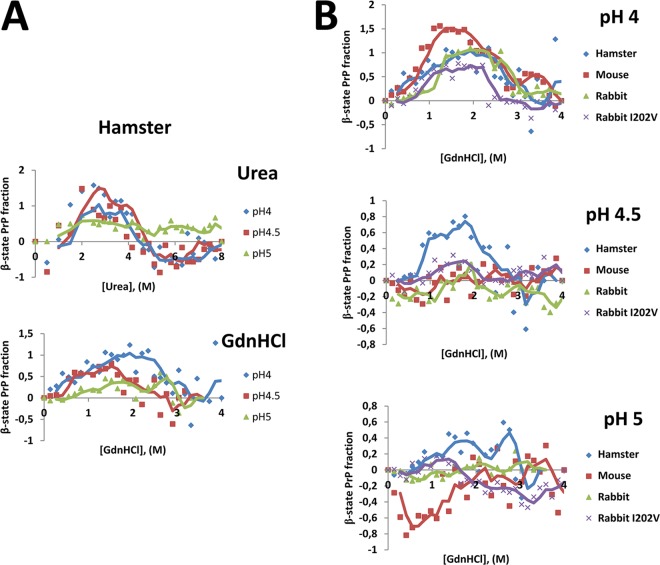FIG 11.
The β-state acquisition proneness of rabbit I202V rec-PrP upon treatment with chaotropic agents was not altered with respect to that of wild-type rabbit rec-PrP. (A) Fractions of hamster rec-PrP that acquired the β-state upon treatment with increasing concentrations of urea or GdnHCl at pH 4, pH 4.5, and pH 5. The y axis shows the fractions of rec-PrP that acquired the β-state under specific pH conditions. The x axis shows increasing concentrations of the chaotropic agent used in each case. Measurement of the β-state fraction was performed by circular dichroism assay at pH 4, 4.5, and 5, as the β-state proneness is higher under more acidic conditions. The β-state acquisition patterns were very similar with both chaotropic agents, with most of the hamster rec-PrP being in the β-state at pH 4 and 4.5 between 2 M and 4 M in the case of urea and between 1 M and 2 M in the case of GdnHCl. (B) Fractions of hamster, mouse, rabbit, and rabbit I202V rec-PrPs that acquired the β-state upon treatment with increasing concentrations of GdnHCl at pH 4, pH 4.5, and pH 5. The y axes show the fractions of rec-PrP that acquired the β-state under various pH conditions. The x axes show the increasing concentrations of GdnHCl used. Measurement of the β-state fraction was performed by circular dichroism assay at pH 4, 4.5, and 5. The measurements are grouped by pH, since the rec-PrPs which showed higher levels of β-state acquisition were the ones that showed greater fractions of β-state under pH conditions closer to neutral. In all the plots, trend lines are included as a guide. No differences in β-state acquisition proneness were detected between mouse, rabbit, and rabbit I202V rec-PrPs, indicating that the higher misfolding ability shown previously for mouse and rabbit I202V rec-PrPs than that for wild-type rabbit rec-PrP is not associated with their β-state acquisition proneness.

